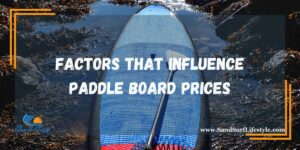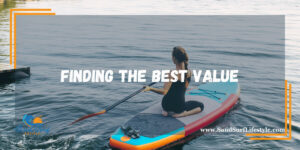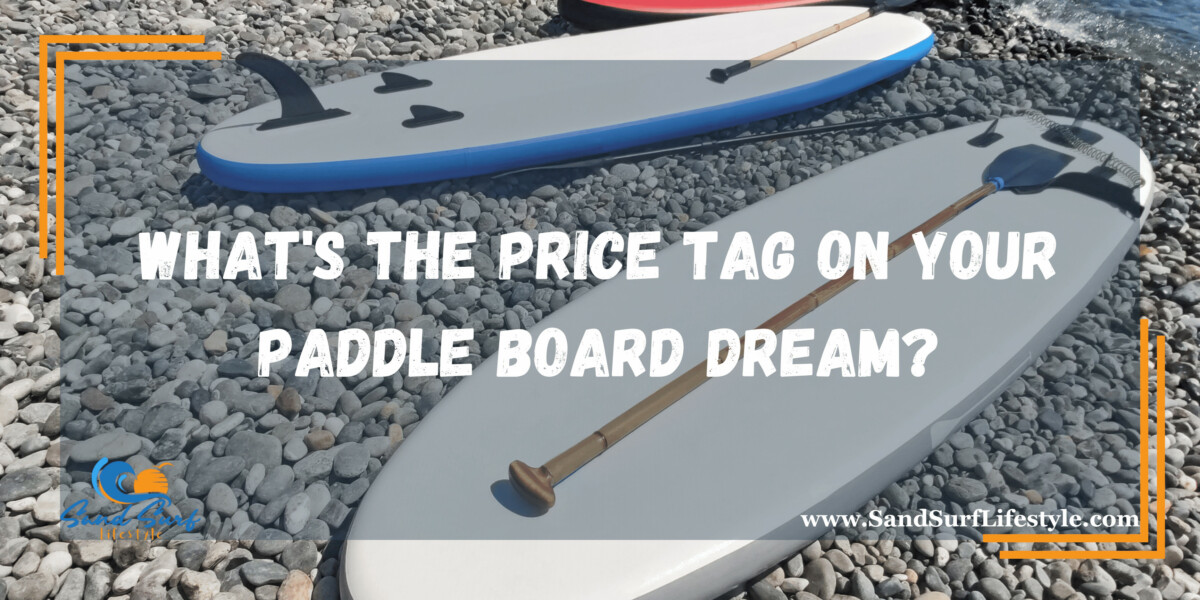Paddleboarding has surged in popularity in recent years, offering a versatile and enjoyable way to explore the water and stay active. Whether you’re a seasoned enthusiast or a beginner looking to embark on this water-based adventure, understanding the cost of paddle boards is crucial.
Factors That Influence Paddle Board Prices

Before we get into specific price ranges, it’s essential to grasp the factors that can significantly impact the cost of a paddle board. Here are the key variables to consider:
1. Type of Paddle Board
Paddle boards offer a diverse range of types, each tailored to specific activities and skill levels. For instance, all-around boards are versatile and ideal for beginners, making them budget-friendly options. On the other hand, touring boards, engineered for long-distance paddling, often sport premium price tags due to their specialized design, improved tracking, and additional features. Racing boards, built for competitive speed, also tend to be more expensive, boasting cutting-edge materials and streamlined shapes. Meanwhile, inflatable paddle boards, designed for portability and convenience, are generally more affordable and constructed from robust PVC materials that contribute to their budget-friendly appeal.
2. Materials
The composition of a paddle board’s materials profoundly influences its cost. Traditional hard boards, crafted from epoxy or fiberglass, are renowned for their durability and superior performance, making them pricier options. These materials contribute to their rigid structure and excellent responsiveness to the water. Conversely, inflatable paddle boards, designed for accessibility and ease of transportation, rely on durable PVC materials, which keep their cost lower. While inflatables may not match the hard boards’ performance level, they offer a more budget-friendly entry point for paddlers.
3. Size and Dimensions
Paddle boards exhibit varying dimensions, encompassing length, width, and thickness, which contribute significantly to pricing. Longer paddle boards, often exceeding 11 feet, provide enhanced stability and improved tracking, making them suitable for various activities, including touring and racing. These longer boards tend to be more expensive due to the additional materials used in their construction. In contrast, shorter and narrower boards emphasize maneuverability and agility, suiting those seeking a budget-friendly option for activities like surfing and casual paddling.
4. Brand and Reputation
Paddleboard pricing is also heavily influenced by brand recognition and reputation. Well-established brands with a history of delivering quality, durability, and innovation tend to command higher prices for their products. Paddlers often trust these brands for their craftsmanship and reliability, which can justify the premium cost. However, it’s important to note that lesser-known brands can offer competitive options with similar quality and features at more affordable price points. Savvy shoppers may find hidden gems among these brands while staying within their budget.
5. Features and Accessories
Paddleboards can come equipped with a range of features and accessories that contribute to their overall price. These extras are designed to enhance the paddling experience. Features such as bungee cords, deck pads, and paddle holders provide convenience and functionality, but they can also elevate the cost. Additionally, paddle boards often include carry bags for easy transportation and storage, adding value to the package. While these accessories can increase the price, they may be worth the investment for those seeking a more complete and enjoyable paddling experience.
To discover the top paddle board brands, check out this article.
Price Ranges for Paddle Boards
Now that you’re familiar with the factors affecting paddle board prices, let’s explore the general price ranges you can expect to encounter:
1. Entry-level paddle Boards (Under $500)
Entry-level paddle boards serve as a welcoming gateway to the world of paddleboarding, especially for those looking to embrace the sport without making a substantial financial commitment. These boards are thoughtfully designed with budget-conscious beginners in mind. They often come in the inflatable variety, crafted from robust PVC materials that make them remarkably durable despite their economical price point.
While entry-level paddle boards may lack some of the high-end features found on pricier models, they are perfectly suited for recreational use. Novice paddlers will find these boards stable and easy to maneuver, which is essential for building confidence on the water. Whether you’re exploring tranquil lakes, meandering down calm rivers, or even catching some waves at the beach, these boards are a reliable and cost-effective choice to get started on your paddleboarding journey.
2. Mid-Range Paddle Boards ($500 – $1,000)
The mid-range paddle board category offers paddlers a diverse and appealing array of options that strike a harmonious balance between affordability and quality. Priced between $500 and $1,000, these boards cater to a broad spectrum of paddlers, from casual adventurers to more experienced enthusiasts.
Within this category, you’ll find a mix of inflatable and hard boards, allowing you to choose the type that best aligns with your preferences. Whether you prioritize convenience and portability with an inflatable model or seek the enhanced performance and rigidity of a hard board, mid-range boards provide both options.
One of the key advantages of mid-range paddle boards is their versatility. They are often available in various sizes, accommodating different body types and skill levels. Whether you’re planning leisurely excursions, fitness paddling, or even light touring, mid-range boards offer the features and durability to match your aspirations without straining your budget.
3. High-End Paddle Boards ($1,000 – $2,000+)
High-end paddle boards represent the pinnacle of paddleboarding excellence, tailor-made for devoted enthusiasts and those who demand the utmost in performance and craftsmanship. These boards typically command price tags ranging from $1,000 to $2,000 or even higher, depending on their specialized attributes.
What sets high-end paddle boards apart is the exceptional quality of their construction materials. Often crafted from premium materials such as fiberglass, carbon fiber, or advanced composite blends, these boards achieve a rare combination of lightweight agility, incredible rigidity, and unparalleled responsiveness on the water.
Beyond their superior materials, high-end boards are designed with a specific purpose in mind. Whether you’re an avid racer, an intrepid touring enthusiast, or a dedicated surfer, there’s a high-end board tailored to your needs. These boards may feature cutting-edge shaping and design elements, including streamlined profiles, optimized hulls, and advanced fins, all of which contribute to their exceptional performance characteristics.
Additional Costs to Consider
When budgeting for your paddle board purchase, it’s essential to factor in additional costs beyond the board itself:
1. Paddle
A paddle is more than just an accessory; it’s a critical component of your paddleboarding experience. The price of a paddle can vary significantly, with options ranging from $50 to $300 or more. This variance is often attributed to the materials and design used in its construction. High-quality paddles are typically crafted from lightweight and durable materials like carbon fiber or fiberglass, offering enhanced performance, responsiveness, and reduced fatigue during extended paddling sessions. While budget-friendly paddles provide a cost-effective entry point, investing in a higher-quality paddle can greatly enhance your enjoyment and efficiency on the water.
2. Leash
A paddleboard leash is a vital safety accessory that should not be overlooked. These leashes are designed to prevent your board from drifting away if you fall off, helping you stay connected to your board and ensuring a safer paddleboarding experience. Basic paddle board leashes are affordable, with prices typically ranging from $10 to $30. They come in various lengths and styles to suit your preferences. While a basic leash provides essential functionality, some paddlers opt for coiled or retractable versions for added convenience and reduced drag in the water.
3. Personal Flotation Device (PFD)
Safety should always be a top priority when paddleboarding, making a suitable Personal Flotation Device (PFD) indispensable. PFDs are available at a wide range of price points, but it’s crucial not to compromise on quality when choosing one. Prices for PFDs can vary based on factors such as design, buoyancy, and additional features. A reliable and comfortable PFD can typically be found in the $50 to $100 range. Investing in a PFD that fits properly, is Coast Guard-approved, and suits your paddling style ensures that you’re adequately protected while out on the water.
4. Transportation and Storage
When considering the overall cost of paddleboarding, it’s important to account for transportation and storage solutions. If you don’t have a vehicle equipped with roof racks, you may need to invest in a rack system, which can cost anywhere from $50 to $500 or more, depending on the type and brand. Additionally, transport bags designed specifically for paddle boards can range from $50 to $150. Proper storage solutions, such as wall mounts or stands, can also incur extra expenses but are essential for prolonging the life of your board and keeping it in optimal condition.
5. Maintenance and Repairs
Over time, your paddle board may require maintenance or repairs, which should be factored into your budget. Common maintenance tasks include cleaning, checking for dings or cracks, and ensuring that fins and fin boxes are secure. If you do encounter damage, such as a ding or a damaged fin, budget for the cost of repairs, which can range from $20 for minor fixes to $100 or more for more extensive repairs. Regular maintenance and prompt repairs are crucial for preserving the longevity and performance of your paddle board.
Finding the Best Value

While price is undoubtedly a significant factor when purchasing a paddle board, it’s equally important to consider value for your investment. Here are some tips to help you find the best value for your budget:
1. Research Extensively
To make an informed paddle board purchase, thorough research is key. Spend time exploring different brands, models, and features. Dive into customer reviews to gain insights into real-world experiences and durability. Price comparison is crucial; ensure you’re getting value for your investment by comparing boards with similar attributes. This diligent research equips you with the knowledge needed to make a well-rounded decision, helping you find the right board that fits your preferences and budget.
2. Consider Used or Demo Boards
If budget constraints are a concern, consider the cost-effective option of purchasing a used or demo board. Many retailers offer discounted prices for lightly used models, providing an affordable entry into the sport. Before purchasing, inspect the board carefully for any wear or damage, and inquire about its history. While it may not be brand new, a well-maintained used or demo board can deliver a rewarding paddling experience without straining your finances.
3. Visit Local Retailers
Paying a visit to local paddle board shops offers invaluable advantages. Interacting with knowledgeable staff who are passionate about the sport can provide you with expert advice and recommendations tailored to your needs. Additionally, physically examining different boards allows you to assess their build quality, size, and features up close. These hands-on experiences can significantly contribute to your decision-making process, ensuring that the board you choose aligns perfectly with your expectations.
4. Test Before You Buy
Whenever possible, take the opportunity to test paddle boards on the water before making a purchase. This firsthand experience allows you to assess how a board performs in real conditions, such as stability, maneuverability, and tracking. Testing multiple boards provides a direct comparison, enabling you to pinpoint which one best suits your paddling style and preferences. It’s a valuable step in ensuring that the board you select complements your skill level and enhances your enjoyment on the water.
5. Consider Long-Term Costs
While a lower-priced paddle board may initially seem appealing, it’s essential to evaluate the long-term costs associated with your purchase. Factor in potential expenses such as maintenance, repairs, and upgrades down the line. A lower-priced board may require more frequent maintenance or limit your ability to adapt it to evolving preferences. Weighing these long-term costs against your initial budget can help you make a more informed decision and ensure that your paddle board investment remains enjoyable and cost-effective over time.
To learn about the wardrobe essentials for a day of paddle-boarding fun, check out this article.
Conclusion
The price of a paddle board can vary significantly based on factors like type, materials, size, and brand. By understanding these factors and considering your specific needs and preferences, you can find a paddle board that offers both value and an enjoyable paddling experience. Remember that while price is important, it’s equally crucial to prioritize safety, quality, and your overall enjoyment of this exciting water sport.
– Consider factors beyond price, such as safety, quality, and how well the board suits your needs and preferences, to determine its overall value.
Please note that the contents of this blog are for informational and entertainment purposes only and should not be construed as legal advice. Any action taken based on the information provided in this blog is solely at your own risk. Additionally, all images used in this blog are generated under the CC0 license of Creative Commons, which means they are free to use for any purpose without attribution.

